Parry's 1827 Fogbow & its Supernumerary Colours - OPOD
Parry's 1827 Fogbow & its Supernumerary Colours
Atmospheric optics never fails to amaze with its diverse range of optical phenomena. One such fascinating occurrence is the fogbow, which was observed by the renowned British Arctic explorer, William Edward Parry, on July 23, 1827. While fogbows are a common sight in Polar regions, this particular fogbow stood out due to its unique characteristics.
Parry and his team embarked on a challenging expedition to reach the North Pole by trekking over the ice from north of Svalbard. However, their journey was hindered by numerous obstacles, including open water leads and unfavorable weather conditions. Despite their valiant efforts, the ice was drifting southwards at a pace that matched their northward progress. Three days after sighting the fogbow, they were forced to abandon their quest for the pole. Nonetheless, they achieved a record furthest north of 82° 45', a feat that remained unbeaten for nearly half a century.
What made Parry's fogbow noteworthy were the unusually large number of supernumerary bows within the primary bow and their peculiar colors. Typically, fogbow supernumeraries display red hues on their inner sides. However, Parry reported the first supernumerary as having a red hue on its outside, which was quite unexpected.
Considering the challenging conditions they faced—exhaustion, undernourishment, and snow blindness—it is commendable that Parry managed to make such detailed observations. Although there may have been room for error given the circumstances, it is crucial to evaluate his findings.
Upon closer examination, it becomes apparent that Parry's observations were indeed accurate. When fogbow simulations were conducted using Mie scattering theory, it was observed that as droplet size increased, the supernumeraries became narrower and crowded closer together towards the center of the bow. This aligns with Parry's records. Additionally, the colors of the supernumeraries deepened as the droplet size increased. For droplets up to 100 microns in diameter, all the supernumeraries displayed red hues on their inner sides. However, when the droplet size reached 200 microns, a subtle change occurred. The first supernumerary exhibited a definite red hue on its outside or between itself and the main bow.
It is important to note that Parry's fogbow was produced by droplets in the air with diameters ranging from 150 to 200 microns or larger. Had the droplets been too large, Parry would have reported a rainbow instead. Thus, Parry's observations were not only accurate but also provide valuable insights into the conditions necessary for fogbows to form.
The colors observed in fogbows and their supernumeraries are a result of the overlapping of all the spectral colors of sunlight. Several factors influence how these colors combine to produce white light supernumeraries. Firstly, red supernumeraries are spaced wider apart than those with shorter wavelengths. Secondly, the width of supernumeraries (and the primary bow) decreases from red to violet. Additionally, the radius of the primary bow decreases as we move from red to violet. Finally, yellows and greens are more intense than violets and deep reds. When all these factors are taken into account, the result is a "normal" fogbow, where reds appear closer to the inner edge of the first supernumerary and greens contribute more to its outer edge.
However, as droplet size increases to around 180 microns in diameter, the interaction of these effects changes the coloration of fogbows. Violet from the primary bow partially overlaps with the outer edge of the first supernumerary, while deep red supernumeraries show less movement towards the center of the bow. Consequently, the outer edge of the first supernumerary becomes a mixture of reds, yellows, and primary bow violet, giving rise to the reddish hue observed by Parry.
Parry's keen observation skills are further exemplified by his earlier discovery of an upper suncave Parry arc during the search for the North West Passage. He also accurately depicted two arcs that were initially believed to be incorrectly drawn infralateral arcs but were later identified as correctly placed subhelic arcs by halo experts.
In conclusion, Parry's 1827 fogbow and its supernumerary colors provide valuable insights into the formation and characteristics of fogbows. Despite challenging conditions, Parry's observations were accurate and shed light on the relationship between droplet size and the appearance of fogbow supernumeraries. This knowledge enhances our understanding of atmospheric optics and adds to the wonder and intrigue of these captivating natural phenomena.
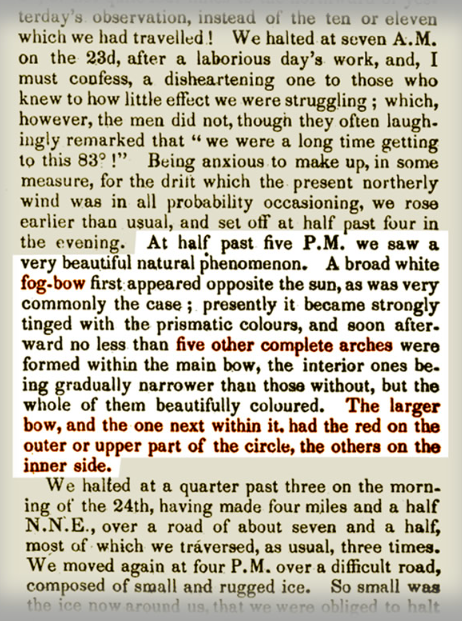
Parry's Fogbow
The famed British Arctic explorer William Edward Parry (1790–1855) describes a fogbow seen on July 23,1827. As Parry notes, fogbows are two a penny in Polar regions but this one was unusual.
Parry and thirteen others were attempting to reach the North Pole by trekking over the ice from north of Svalbard. Because of frequent leads of open water and the then current theory that there could be an 'open polar sea' they man hauled two boats mounted on skis. They started late in the season and conditions were atrocious. There was slush, moving floes, lakes, heavy rain and rough broken ice. To their chagrin they discovered that the ice was drifting south almost as fast as they could drag their boats northwards. Three days after the fogbow sighting they abandoned the pole attempt. They reached a record furthest north of 82� 45� only bettered 49 years later by another British expedition.
The fogbow was notable both for its unusually large number of supernumerary bows inside the main primary and for their colour. Fogbow supernumeraries have their reds on the inside yet, strangely, Parry reports the first one as red on its outside?
They were exhausted, they were undernourished, they were starting to suffer from snow blindness. That Parry made a detailed observation at all is commendable. Given the conditions it would be understandable if he erred.
Did he get it wrong?
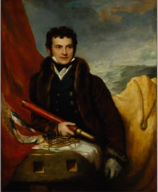
Sir William Edward Parry painted by Samuel Drummond 1820 (NPG 5053).
Courtesy of The National Portrait Gallery, London, shown with permission.
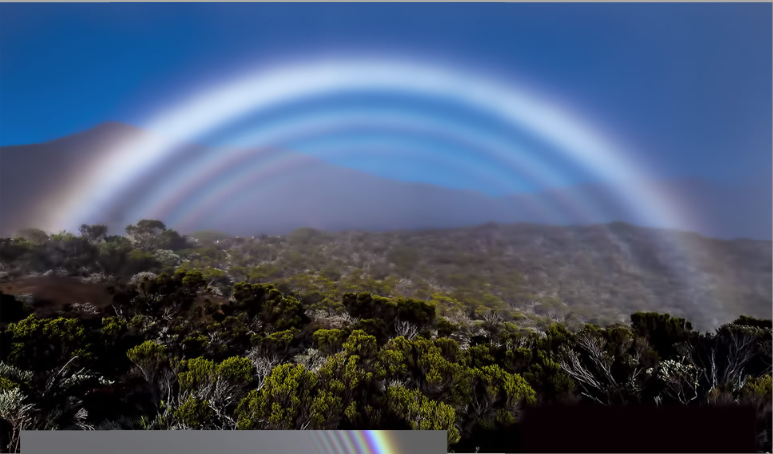
An intense fogbow sighted by Jean-François Begue on La Réunion Island in the Indian Ocean.
Like Parry's fogbow, several supernumeraries nestle inside the main bow. Also as described by Parry, their spacing narrows towards the centre.
BUT.. ..All the supernumeraries have red hues on their insides.
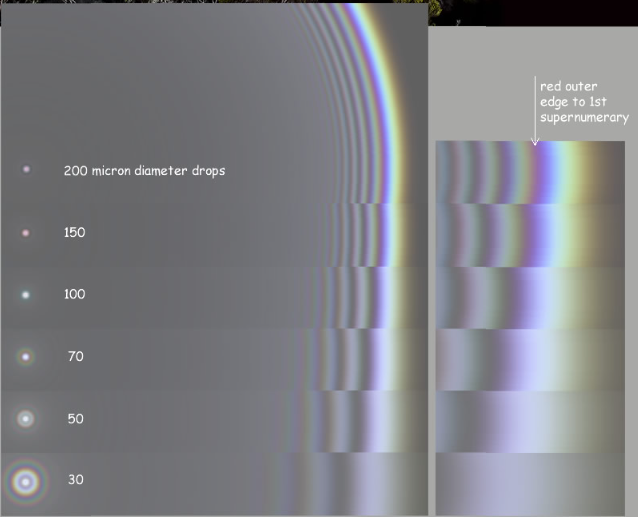
Parry was correct
At left, computed (Mie scattering theory, IRIS) fogbows made by one size droplets. Their diameters increase from 30 to 200 micron (0.2mm). The circles are the central glory. An added grey sky background shows their visual appearance. The section at right has the same bows expanded to better reveal the colours.
As the droplets get larger, the supernumeraries narrow. They crowd closer. Their visible number increases. Their spacing decreases towards the bow centre - Parry recorded this.
Colours deepen as the drop size increases. At usual fog drop sizes of up to 100 micron diameter all the supernumeraries have red on their insides (towards the bow centre). Then there is a change.
200 micron drops produce a definite red hue on the outside of the first supernumerary or at least between it and the main bow. The change is subtle and needs careful observation.
Parry was correct. His fogbow was produced by droplets in the air 150-200 micron diameter or larger. But not too large otherwise he would have reported it as a rainbow.
He made accurate observations under very demanding conditions. He recorded them well. One is reminded of his earlier halo observation made during the search for the North West Passage. He clearly showed what is now called an upper suncave Parry arc. More notably he also drew two arcs claimed by halo experts to be incorrectly drawn infralateral arcs. They are actually quite correctly placed subhelic arcs.
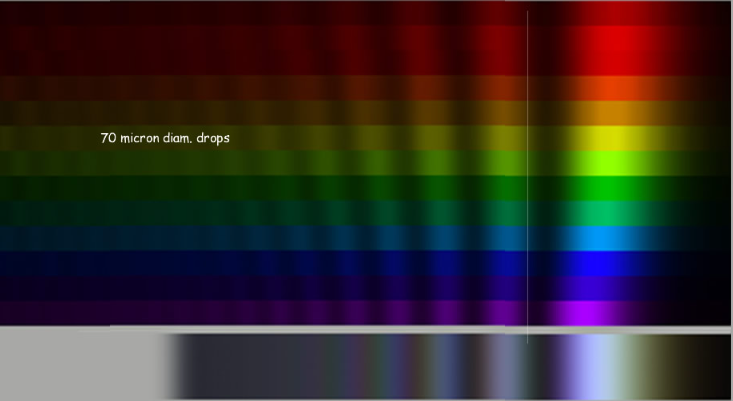
Colour make up
White light fogbows and their supernumeraries (SNs) are composites of all the spectral colours of sunlight.
At left IRIS computes fogbow cross-sections for individual colours and sunlight. The drops were 70 micron diameter.
At least four factors influence how the colours overlap to produce white light SNs
-
Red SNs are wider spaced than shorter wavelength ones.
-
SN (and primary bow) width decreases at red to violet
-
The primary bow radius decreases from red to violet.
-
Yellows and greens are most intense, violets and deep reds less so.
The total effect for 70 micron drops is that reds �hang over� the inner edge of the white light first SN. Greens contribute most to its outer edge. A 'normal' fogbow.
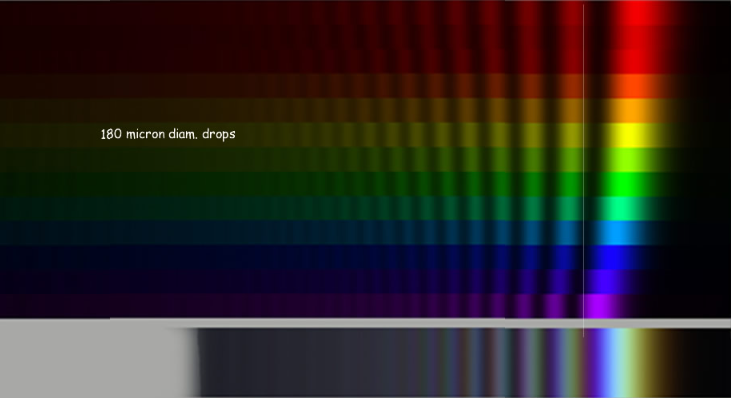
The interacting effects combine differently to colour fogbows from 180 micron diameter droplets.
Violet from the primary bow partially overlaps the outer edge of the first SN. Deep red SNs move less strongly to the bow centre.
The first SNs outer edge is a mixture of reds, yellows and primary bow violet. They combine to give Parry's reddish hue.
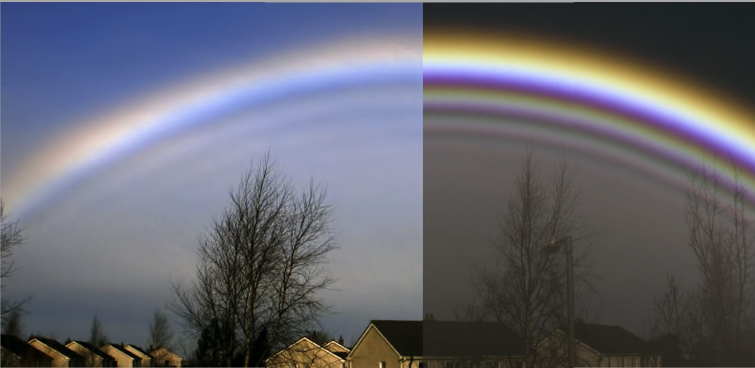
�A fogbow or cloudbow
Seen by Simon Holt at Naas, Co. Kildare, Ireland.
At right, a matching IRIS simulation for droplets of mean diameter 150 micron.
The simulation shows a reddish colouration outside the first supernumerary. It is just visible (if you know it is there) on the image.
Its low visibility illustrates the acuteness of Parry's observation of a similar bow.
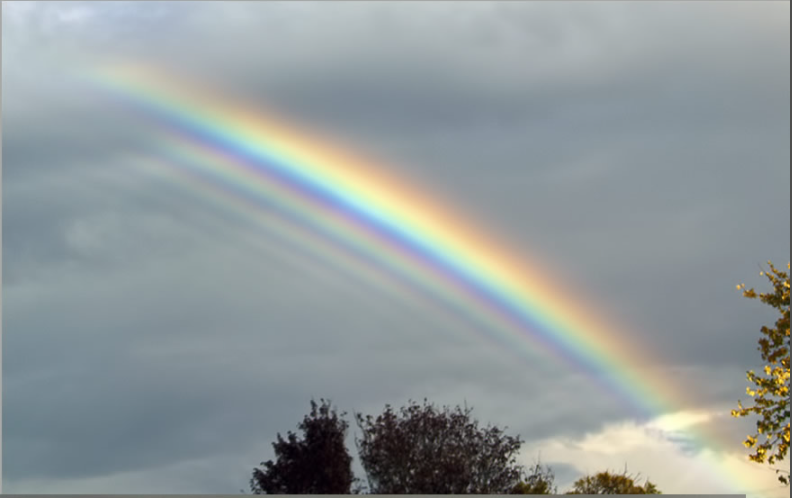
The drops are larger here. We have a rainbow - although the line dividing a fogbow and rainbow is a vague one.
The 1st, 2nd and possibly the third supernumeraries now all have red on their outsides.
Lisa Gonnelli pictured this in New Jersey, USA.
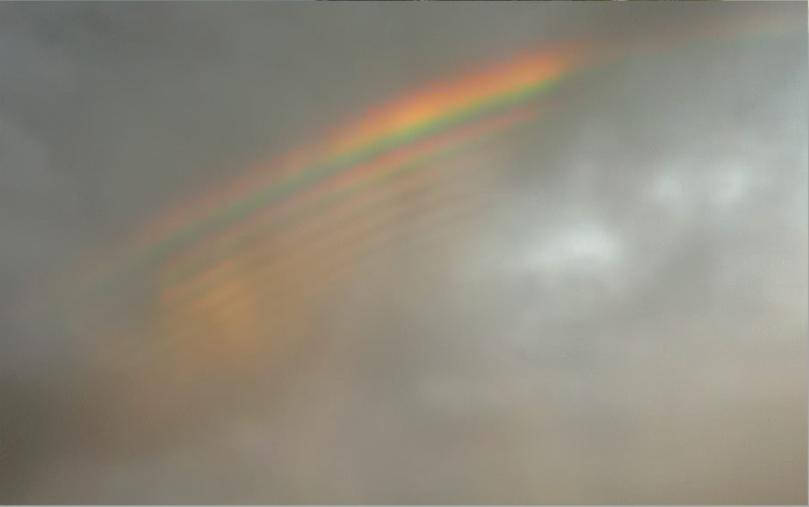
An amazing number of supernumeraries in an image by Denis Betsch taken near Strasbourg, Alsace, France.
The raindrops were of almost the same size. Helped too by the highly reddened sunset light. Supernumeraries are more easily visible in near monochromatic light as evidenced by the simulations above.
These supernumeraries have red on their outside.
The change from red on the SN inside to outside starts at a drop size of 150 - 200 micron diameter. At larger drop sizes the fogbow/rainbow supernumeraries increasingly show outside reds.
A thank you to Monika Landy-Gyebnar for flagging the Parry observation and questioning his colour description. The book extract is from W.E. Parry, 'Three Voyages for the Discovery of a Northwest Passage from the Atlantic to the Pacific, and Narrative of an Attempt to Reach the North Pole', London, 1835 - See Gutenberg.
Note: this article has been automatically converted from the old site and may not appear as intended. You can find the original article here.
Reference Atmospheric Optics
If you use any of the definitions, information, or data presented on Atmospheric Optics, please copy the link or reference below to properly credit us as the reference source. Thank you!
-
<a href="https://atoptics.co.uk/blog/parrys-1827-fogbow-its-supernumerary-colours-opod/">Parry's 1827 Fogbow & its Supernumerary Colours - OPOD</a>
-
"Parry's 1827 Fogbow & its Supernumerary Colours - OPOD". Atmospheric Optics. Accessed on April 20, 2024. https://atoptics.co.uk/blog/parrys-1827-fogbow-its-supernumerary-colours-opod/.
-
"Parry's 1827 Fogbow & its Supernumerary Colours - OPOD". Atmospheric Optics, https://atoptics.co.uk/blog/parrys-1827-fogbow-its-supernumerary-colours-opod/. Accessed 20 April, 2024
-
Parry's 1827 Fogbow & its Supernumerary Colours - OPOD. Atmospheric Optics. Retrieved from https://atoptics.co.uk/blog/parrys-1827-fogbow-its-supernumerary-colours-opod/.